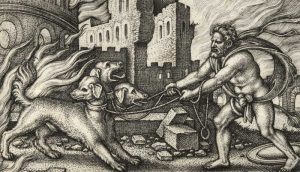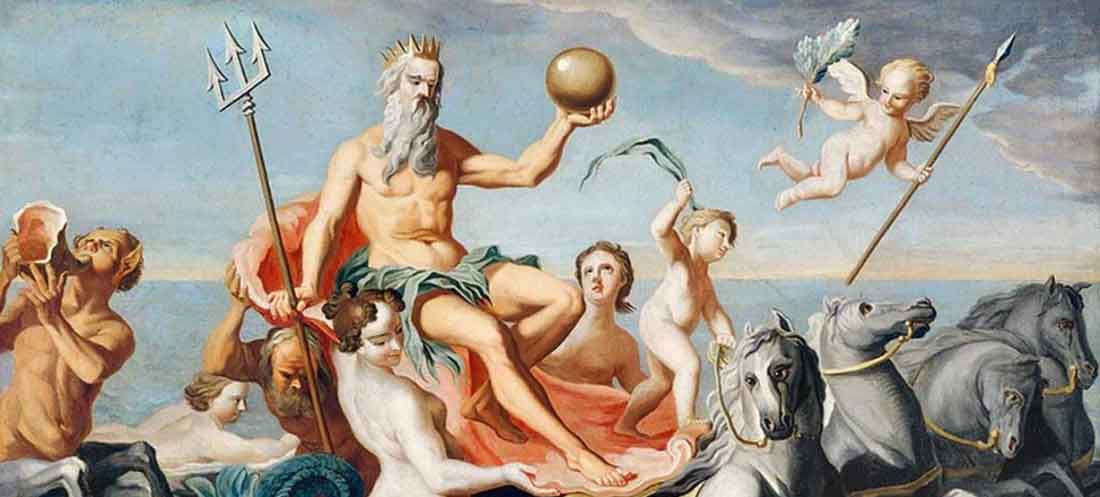Cerberus Greek mythology

Cerberus’ mother was Echidna, also known as the “mother of all monsters”.
It had black eyes, the head and torso of a beautiful woman, and the tail of a snake. Echidna in mythology lured unsuspecting men with her beauty and then ate their raw flesh.
Cerberus’ primary role was to tirelessly guard the gates of the Underworld and faithfully serve the god Hades. Chained to the gates of Acheron, he made sure to devour anyone who tried to escape from the world of the dead in order to return to the living.
One of the few times Cerberus was defeated was when Heracles met him near the Acheron River Gate. He made a mighty defensive shield, covered his head with a lion’s skin, and when he caught him, he clasped the beast’s head with his hands.
Even though the dragon kept throwing fire at him, he didn’t stop until he surrendered. He caught him and brought him to King Eurystheus, who out of fear immediately sent him back to Hades. It was the twelfth and most difficult labor of Heracles.
Orpheus, on the other hand, was the only one who managed to put the mythical monster to sleep with his lyre in order to pass through the gates of Hades to find his lost wife Eurydice.
The gods of the Underworld promised the brave youth to give him Eurydice, but warned him not to turn back to look at her until they passed the entrance to the Underworld and emerged into the light. But he, in his impatience to see his wife, forgot and looked at her, so Eurydice disappeared forever and was never seen again.
Orpheus and Eurydice flee the Underworld after Cerberus had fallen asleep. Painting by artist Edward Poytner, 1862. Photo source: (Wikimediamtx Commons)
Orpheus and Eurydice leave the Underworld after Cerberus has fallen asleep. Painting by artist Edward Poytner, 1862
Cerberus appears in many works of ancient literature, although the depiction surrounding the mythical monster often differs between authors and cultures.
In Dante’s Inferno, he guards the third circle of Hell, not the entire underworld. Greek poets such as Hesiod and Horace gave different versions of the monster, since in each description Cerberus had fifty or a hundred heads and was a wolf or a lion respectively.
Cerberus and Heracles
Herakles, before departing for Cape Tainaro in Laconia (according to others for Heraclea in Pontus), where the mouth leading to Hades was located, went to Eleusis, to purify himself from the killing of the Centaurs and then to be initiated into the mysteries they taught the ways to safely reach the Underworld after death. Purified and initiated, he began the descent into the Underworld. At the command of Zeus, Hermes and Athena attended him.
Heracles met various dead people who were disappearing in his path, except for the Mermaid Medusaexos and Meleager. He drew his sword against Medusa and wanted to cross Meleager. For the first Hermes warned him that it was just a shadow. The latter approached him and with his touching story of his life and death disarmed the tearful Herakles.
It was then that she promised him that she would marry one of his sisters if there was one alive. Thus he committed himself to marry Deianeira. In the darkness of the Underworld he also met the living captives of Theseus [Fig. 537] and Peirithos and the martyr Askalaphoexos who freed him from the torture that Demeter had imposed on him as a punishment, i.e. to be imprisoned under a huge rock, rolling him over. He also met the shepherd of the Menoite Underworld flocks who would have killed him if Persephone had not intervened.
And he would kill him, because the Menoite tried to prevent him from slaughtering some animals from the herds of Hades, to give some life to the dead with the blood that would be shed and the dead would drink, as Odysseus had done. The Menoitis escaped with several broken ribs.
When he arrived before Pluto, he asked him for Cerberus, and he allowed him to take him, on condition that he tame him without using shield or iron weapons, wearing only his breastplate and lion. The hero found Cerberus at the gates of the Acheronexos, and, well protected by his breastplate, and wrapped well with the lion as a shield, wrapped his arms around the dog’s head, and did not cease to hold and squeeze him, until he the dog, although he was terribly stung by the snake that was on the tail of Cerberus, like a scorpion.
Having, therefore, caught him, he carried off his booty, attempting, with the help of Athena, the ascent from Troizena, or from the sanctuary of Clymenus, to Ermione in the Argolis, or from Mount Laphistia in Boeotia, or from a mouth in the peninsula of Acherusias to the Pontic Herakleia .
And as Cerberus was accustomed only to darkness, as soon as they came out, he was dazzled by the sun, and spewed out of his mouth gall which fell on the earth; in that place grew the poisonous plant aconite. In addition, in Olympia it was said that Heracles brought from Hades the white poplar, the only wood allowed in the sacrifices to Zeus.
As far as Mycenae, where Herakles and Cerberus passed through, women and children were frightened by the monster with the eyes that threw lightning. Eurystheus was so frightened at the sight of the dog that hid in the copper jar that he had as a shelter in case of danger – he also fled there when Heracles brought him the Erymanthian boar. And either Eurystheus asked Heracles to return Cerberus back to Hades or the hero decided it himself, because he didn’t know what to do with him. Others say that he released Cerberus at the spring of Cynadra, on the road from Heraeus to Mycenae, and alone the Hound of Hades descended to his place.
Was Cerberus a real dog?
A more rational interpretation wants Cerberus to be a real dog that, together with the other dog, Orthros, guarded Geryon’s flocks. Hercules killed Orthros and delivered Cerberus to Eurystheus. A neighbor of his, Molottus, asked him for it, but Eurystheus refused to give it to him. That is why he also had his shepherds steal him and shut him up in a mountain cave in Tainaro along with female dogs to reproduce.
Eurystheus asked Heracles to find him the precious dog. He wandered all over the Peloponnese until he found him, went down to the cave and then went up with Cerberus and handed him over to his master – so the people said “because of the man’s descent to Aedus, Hercules brought the dog”
Pausanias, conveying the opinions of others, also gives a rational interpretation to the myth but in a different way: In some Greek poems it is mentioned that Heracles brought the dog of Hades to the surface in this place [Tainarus], although there is no passage in the cave to it leads underground, nor is it easy to convince one that there is some hypochthonic space where souls gather.
But Ecataios the Milesian found a logical interpretation arguing that there was a terrible snake in Tainaros that had been called the Dog of Hades, because anyone who bit him died instantly from the poison. He says that Hercules brought this snake to Eurystheus. Homer, who first called the creature brought by Hercules the Hound of Hades, neither gave it a special name nor presented it as a multiple being, like the Chimaera.
The later ones called him Cerberus and, while otherwise they presented him as a dog, they said he was three-headed. Homer did not identify it as a dog, man’s companion, but it could also be a snake, calling it simply the Hound of Hades
